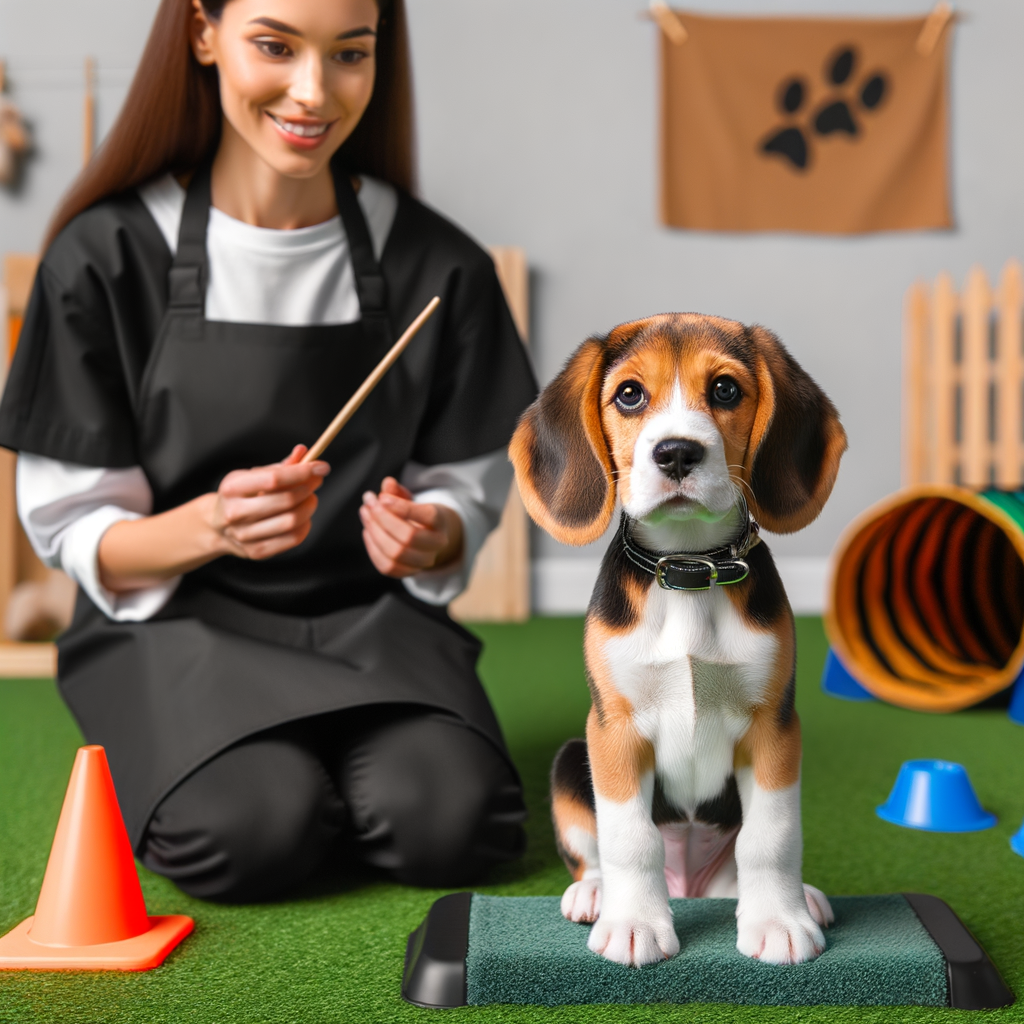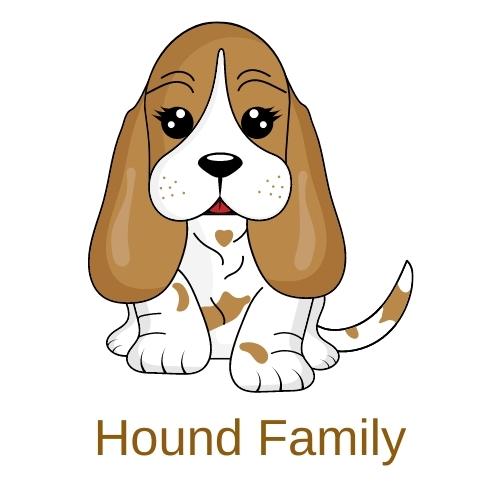
Introduction to Beagle Puppy Training
Training a beagle puppy is a rewarding experience that sets the foundation for a long, happy life together. This guide will help you understand the importance of training and set the right expectations for the process.
- Understanding the Importance of Training a Beagle Puppy
- Setting the Right Expectations
Training your beagle puppy is not just about teaching them to sit or stay. It’s about shaping their behavior and instilling good habits that will last a lifetime. It’s also about strengthening your bond with your puppy and ensuring they grow up to be a well-behaved, sociable, and happy dog.
Training is also crucial for your puppy’s safety. A well-trained dog is less likely to run off and get lost or get into dangerous situations. They’re also easier to manage in public places, making outings more enjoyable for both of you.
Training a beagle puppy requires patience and consistency. Beagles are intelligent and curious, but they can also be stubborn. This means that training might take longer than you expect, and there will be times when your puppy seems to forget everything they’ve learned.
Don’t be discouraged. This is normal. Remember, your puppy is still learning and growing. It’s important to stay patient, keep a positive attitude, and celebrate every small victory along the way.
Setting realistic expectations will help you stay motivated and make the training process more enjoyable for both you and your puppy. Remember, the goal is not to have a perfectly trained puppy overnight, but to build a strong, loving relationship with your beagle that’s based on mutual trust and respect.
Understanding Beagle Puppy Behavior
Beagle puppies are known for their adorable looks and playful nature. However, understanding their behavior is crucial to building a strong bond with them and ensuring their well-being. In this section, we will delve into the common traits of beagle puppies and how to understand their body language.
- Common Traits of Beagle Puppies
- Playfulness: Beagle puppies are full of energy and love to play. They enjoy games of fetch and will often initiate playtime.
- Curiosity: Beagles are naturally curious. They love to sniff and explore everything around them. This trait can sometimes lead them into mischief, so it’s important to keep an eye on them.
- Sociability: Beagles are very sociable dogs. They enjoy being around people and other dogs. They are not typically shy or aggressive.
- Loyalty: Beagles are known for their loyalty. They form strong bonds with their families and are always eager to please.
- Understanding Beagle Puppy Body Language
- Tail Wagging: A wagging tail usually indicates that your beagle puppy is happy and excited. However, a stiff, high wag can sometimes indicate alertness or aggression.
- Ears Back: If your beagle puppy pulls their ears back, it might mean they are scared or anxious.
- Rolling Over: When your beagle puppy rolls over and exposes their belly, it’s usually a sign of submission or a request for belly rubs.
- Yawning: Yawning doesn’t always mean your beagle puppy is tired. It can also be a sign of stress or anxiety.
Beagle puppies are known for their lively and friendly nature. They are extremely curious and love to explore their surroundings. Here are some common traits you might notice in your beagle puppy:
Understanding your beagle puppy’s body language can help you better communicate with them and meet their needs. Here are some common body language signals and what they might mean:
Understanding your beagle puppy’s behavior and body language is key to building a strong bond with them. It allows you to meet their needs and ensure their well-being. Remember, every puppy is unique, so it’s important to spend time with your beagle puppy and get to know them.
Beagle Training Essentials
Training your Beagle puppy can be a rewarding experience. It’s essential to understand the most effective techniques to ensure a successful training process. Let’s explore some of the most effective puppy training techniques.
Puppy Training Techniques
There are a variety of training techniques that can be used when training a Beagle puppy. Here are three of the most effective methods:
- Positive Reinforcement
- Clicker Training
- Leash Training
Positive reinforcement is a powerful training technique. It involves rewarding your puppy when they display good behavior. This can be done with treats, praise, or a favorite toy. For example, if your Beagle puppy sits when you command them to, reward them with a treat. This will encourage them to repeat the behavior in the future.
Clicker training is a method that uses a sound—a click—to tell your puppy when they do something right. The clicker is a small device that a person can carry around with them. When your Beagle puppy does something good, you click the device and then give them a treat. This helps your puppy understand what behaviors are rewarded.
Leash training is essential for any dog breed, including Beagles. It helps keep your puppy safe and makes walks more enjoyable. Start by letting your Beagle puppy wear the leash around the house, so they get used to it. Then, you can start short, supervised sessions outside. Remember to always keep the leash loose and never to pull your puppy along.
Remember, patience and consistency are key when training your Beagle puppy. It may take time, but with these techniques, you’ll have a well-trained Beagle in no time.
Common Training Challenges
Training a Beagle puppy can be a delightful experience, but it also comes with its own set of challenges. Here, we will discuss some of the common training challenges you might encounter and how to address them effectively.
- Dealing with Stubbornness
- Addressing Excessive Barking
- Preventing Destructive Chewing
Beagles are known for their stubborn streak. This can make training a bit tricky. However, patience and consistency are key. Remember, your puppy is not being stubborn to annoy you. They are simply trying to understand what you want from them. Break down commands into simple steps and reward your puppy for each step they get right. This will encourage them to follow your commands.
Beagles are vocal dogs and they love to express themselves through barking. While this is a natural behavior, excessive barking can become a problem. To address this, try to understand what triggers your puppy’s barking. Is it boredom? Anxiety? Once you identify the trigger, you can work on addressing it. For instance, if your puppy barks out of boredom, providing them with toys or engaging them in activities can help.
Chewing is a natural behavior for puppies as it helps them explore their environment and relieve teething discomfort. However, destructive chewing can be a problem. To prevent this, provide your puppy with chew toys. Also, make sure to puppy-proof your home by keeping items you don’t want chewed out of their reach. If your puppy starts chewing something they shouldn’t, redirect their attention to a chew toy.
Remember, training a puppy requires patience and consistency. Don’t get discouraged if your puppy doesn’t get it right away. Keep practicing and eventually, they will get it.
Beagle Puppy Care
When it comes to caring for your Beagle puppy, there are several important aspects to consider. One of the most crucial is their nutrition and diet. This section will provide you with valuable insights on how to choose the right puppy food and understand feeding schedules.
Nutrition and Diet
Proper nutrition is vital for your Beagle puppy’s growth and development. It’s important to understand what type of food is best for them and how often they should be fed.
- Choosing the Right Puppy Food
- Understanding Feeding Schedules
Choosing the right food for your Beagle puppy is essential for their health. Beagle puppies require a diet rich in protein, carbohydrates, and fats. Protein is necessary for their growth, while carbs provide them with energy. Fats, on the other hand, are essential for their skin and coat health. Always opt for high-quality puppy food that is specifically formulated for small breeds.
Feeding schedules are just as important as the food you choose. Beagle puppies should be fed three to four times a day until they are six months old. After that, you can reduce their feeding to twice a day. Always ensure that your puppy has access to fresh water at all times.
Remember, every Beagle puppy is unique and may have different nutritional needs. Always consult with your vet to ensure you’re providing the best diet for your puppy.
Health and Wellness
Your Beagle puppy’s health and wellness are of utmost importance. Let’s explore the key aspects that contribute to a healthy and happy puppy.
- Regular Vet Check-ups
- Vaccination Schedule
- Importance of Regular Exercise
Regular visits to the vet are essential for your Beagle puppy’s health. These check-ups allow the vet to monitor your puppy’s growth and development, and to detect any potential health issues early. According to the American Veterinary Medical Association, puppies should have their first vet visit at around six to eight weeks of age, followed by monthly check-ups until they are four months old. After that, a routine check-up every six months is recommended.
Vaccinations are crucial in protecting your Beagle puppy from various diseases. Your vet will provide a vaccination schedule, which typically starts when the puppy is six to eight weeks old. Core vaccines, including those for rabies, distemper, parvovirus, and adenovirus, are generally given. It’s important to follow the vaccination schedule closely to ensure your puppy is adequately protected.
Regular exercise is vital for your Beagle puppy’s physical and mental health. Beagles are active and energetic dogs that require daily exercise to keep them fit and prevent obesity. Exercise also helps to reduce behavioral problems such as excessive barking or chewing. A good rule of thumb is to provide at least one hour of exercise per day, which can be broken up into smaller sessions. This can include walks, playtime in the yard, or doggy sports.
| Health Aspect | Key Points |
|---|---|
| Regular Vet Check-ups | First visit at 6-8 weeks, then monthly until 4 months, then every 6 months |
| Vaccination Schedule | Starts at 6-8 weeks, includes core vaccines for rabies, distemper, parvovirus, and adenovirus |
| Regular Exercise | At least one hour per day, can be broken up into smaller sessions |
In conclusion, regular vet check-ups, a proper vaccination schedule, and regular exercise are key to your Beagle puppy’s health and wellness. By paying attention to these aspects, you can ensure your puppy grows into a healthy and happy adult Beagle.
Raising Beagle Puppies: A Comprehensive Guide
One of the most important aspects of raising a Beagle puppy is ensuring they are properly socialized. This process involves introducing your puppy to a variety of experiences, environments, and other animals to help them become well-adjusted adults.
Socialization
Socialization is a crucial part of your Beagle puppy’s development. It helps them learn how to interact appropriately with other animals and people, and exposes them to different environments. This can help reduce fear and anxiety in your puppy, and make them more comfortable in various situations.
- Introducing Your Beagle Puppy to Other Pets
- Exposing Your Puppy to Different Environments
Introducing your Beagle puppy to other pets should be done gradually and under controlled conditions. Start by allowing them to sniff each other through a gate or door. Once they seem comfortable, allow them to meet face-to-face, but keep the interactions short and positive. Always supervise these meetings to ensure they remain friendly and non-threatening.
Exposing your Beagle puppy to different environments is also important for their socialization. Take your puppy to different places like parks, pet stores, and on car rides. This will help them get used to various sights, sounds, and smells. Remember to keep these experiences positive and rewarding for your puppy to help them associate new environments with good things.
Remember, socialization is a gradual process and should not be rushed. Each puppy is unique and will adapt to new experiences at their own pace. Be patient and supportive, and your Beagle puppy will grow into a confident and well-adjusted dog.
House Training
House training is a crucial part of raising a Beagle puppy. It involves teaching your puppy where and when to do their business. This section will cover two essential aspects of house training: establishing a routine and dealing with accidents.
-
Establishing a Routine
Establishing a routine is the first step in house training your Beagle puppy. Puppies thrive on routine, and it helps them understand what is expected of them. Start by feeding your puppy at the same times each day. This will help regulate their digestive system and make it easier for you to predict when they need to go out.
Next, take your puppy outside regularly. This should be done first thing in the morning, last thing at night, and after meals, playtime, and naps. Each time your puppy does their business outside, praise them and give them a treat. This will help them associate going outside with positive experiences.
-
Dealing with Accidents
Accidents are a normal part of house training. It’s important to remember that puppies are still learning and mistakes will happen. When an accident occurs, don’t punish your puppy. Instead, clean up the mess quietly and thoroughly to remove any scent that might attract them back to the same spot.
If you catch your puppy in the act, interrupt them gently and take them outside. Praise them if they finish their business there. Remember, patience and consistency are key in house training your Beagle puppy.
In conclusion, house training your Beagle puppy requires patience, consistency, and a well-established routine. It might take some time, but with perseverance, your puppy will eventually understand what is expected of them.
Beagle Puppy Training Tips and Tricks
Training a Beagle puppy can be a rewarding experience, but it’s not without its challenges. Here are some tips and tricks to make the process smoother and more enjoyable for both you and your furry friend.
- Keeping Training Sessions Short and Fun
- Being Consistent with Commands
- Using Treats Effectively
Beagle puppies have a short attention span, so it’s crucial to keep training sessions short, typically around 5 to 10 minutes. Try to make these sessions as fun as possible. Use toys, play games, and give lots of praise. Remember, the goal is to make your puppy associate training with positive experiences.
Consistency is key when training a Beagle puppy. Use the same commands for the same actions every time. For instance, if you use the command “sit” one day and “down” the next, it can confuse your puppy. Stick to one command and use it consistently. This will help your puppy understand what you want them to do faster.
Treats can be a powerful tool for training Beagle puppies. However, it’s important to use them effectively. Always give the treat immediately after your puppy performs the desired action. This will help them associate the action with the reward. Also, try to use small, low-calorie treats. This way, you can give them more treats without worrying about overfeeding.
Remember, patience and consistency are key when training a Beagle puppy. It may take time, but with these tips and tricks, you’ll be well on your way to having a well-trained, happy, and healthy Beagle.
Conclusion: The Joy of Training a Beagle Puppy
Training a Beagle puppy is a journey filled with challenges and rewards. It’s a process that requires patience, consistency, and a lot of love. But the joy that comes from seeing your little furball grow into a well-behaved adult Beagle is incomparable. Let’s reflect on this journey and look forward to the future.
- Reflecting on the Training Journey
- Looking Forward to a Well-Behaved Adult Beagle
Looking back, you may recall the first days when your Beagle puppy was just getting used to its new home. There were probably a few hiccups along the way, like the occasional accident on the carpet or the chewed-up shoe. But with time, patience, and the right training techniques, you’ve seen significant progress.
Remember the first time your Beagle successfully followed a command? That moment of triumph was a testament to your hard work and your puppy’s ability to learn. It’s these small victories that make the training journey so rewarding.
Through consistent training, you’ve not only taught your Beagle puppy how to behave, but you’ve also built a strong bond with them. This bond is the foundation of a long, happy, and healthy relationship with your pet.
As your Beagle puppy grows, so does their capacity to learn and adapt. With continued training and reinforcement of good behavior, you can look forward to having a well-behaved adult Beagle.
Imagine the joy of having a dog that listens to your commands, behaves well around other people and animals, and is a joy to be around. This is the future that you’re working towards.
Remember, training doesn’t stop once your Beagle puppy becomes an adult. It’s a lifelong commitment that ensures your dog remains well-behaved and happy. So, keep up the good work, and enjoy the journey of raising your Beagle.
In conclusion, training a Beagle puppy is a rewarding experience that strengthens the bond between you and your pet. It’s a journey filled with challenges, but the joy of seeing your puppy grow into a well-behaved adult Beagle makes it all worthwhile. So, keep training, keep learning, and most importantly, keep enjoying the company of your wonderful Beagle.








